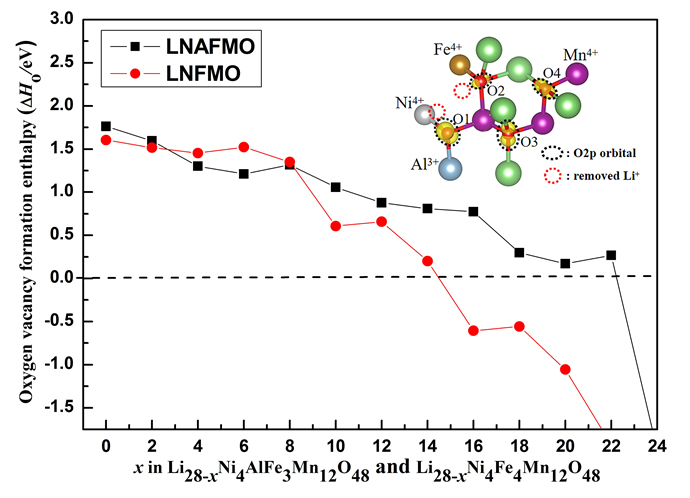摘要/Abstract

锂离子电池(LIB)正极材料比容量及结构稳定性的提高是提升电池整体性能的重要因素. 本工作选取层状无钴正极材料Li(Li0.17Ni0.17Al0.04Fe0.13Mn0.49)O2 (LNAFMO)为研究对象, 使用GGA (generalized gradient approximation)+U (Hubbard U value)方法研究了体系在充电时几何和电子结构变化、氧释放焓、脱锂形成能和脱锂电压. 研究结果表明, 充电时LNAFMO体系首先Ni氧化, 然后Fe氧化, 最后O氧化. 与未掺杂Al的Li(Li0.17Ni0.17Fe0.17Mn0.49)O2 (LNFMO)体系不同的是, 除具有线性Li-O-Li和Fe-O-Li构型的氧离子更容易给出电子外, 具有线性Al-O-Li构型的氧离子也参与电荷补偿, 并且氧离子具有很强的活性, 这将避免参与氧化的氧离子过分集中, 有利于结构的稳定; Al的掺杂能进一步抑制氧的释放, 这将提升体系的结构稳定性和电池循环性能. 该研究为设计一种低经济成本、循环性良好、高能量密度的锂离子电池正极材料奠定了坚实的理论依据.
关键词: 锂离子电池, 富锂正极材料, 掺杂, 阴离子氧化, 第一性原理计算
In lithium-ion battery, lithium rich layered transition metal oxides materials are the next generation of lithium ion cathode materials with high practical specific capacity. The specific capacity and structural stability of cathode materials are two important factors. In order to improve the overall performance of batteries, some strategies such as chemical modifications, surface coating and material composite are used. Among them element doping is an effectively method to improve the electrochemical stability of lithium-rich cathode materials. Li(Li0.17Ni0.17Al0.04Fe0.13Mn0.49)O2 (LNAFMO) as a layered cobalt-free cathode material was selected as the research object. Geometrical structures including the lattice parameters, M―O bond length (where M stands for transition metal) and O―O bond length, electronic structures including oxidation processes of transition metal and oxygen ion, oxygen release enthalpies, delithium formation energies, delithium voltage and the effect of doping element Al are investigated by a GGA (generalized gradient approximation)+U (Hubbard U value) method. Calculated results show that Ni2+ ions in the LNAFMO system are first oxidized, then Fe3+ and finally O2- during the charging. Oxygen ions with linear Al-O-Li configurations in the LNAFMO system participate in charge compensation besides those with linear Li-O-Li and Fe-O-Li configurations, different from the Li(Li0.17Ni0.17Fe0.17Mn0.49)O2 (LNFMO) system without Al doping. The doping of Al can suppress the release of oxygen, improving the structural stability of the system and the cycling performance of the battery. The doping of Al increases the special capacity of LNFMO system (246 mAh•g-1), in which the contribution of Ni/Fe transition metal and oxygen ions to the capacity is equal. The internal mechanism between the oxidation of transition metals and oxygen ions and the geometrical structures in the system has been revealed from a microscopic perspective. This work would provide a theoretical basis for the design of a low cost, high energy density and high cycle performance lithium-ion battery cathode material.
Key words: lithium-ion battery, lithium-rich cathode material, doping, anionic oxidation, first-principles calculation
PDF全文下载地址:
点我下载PDF
